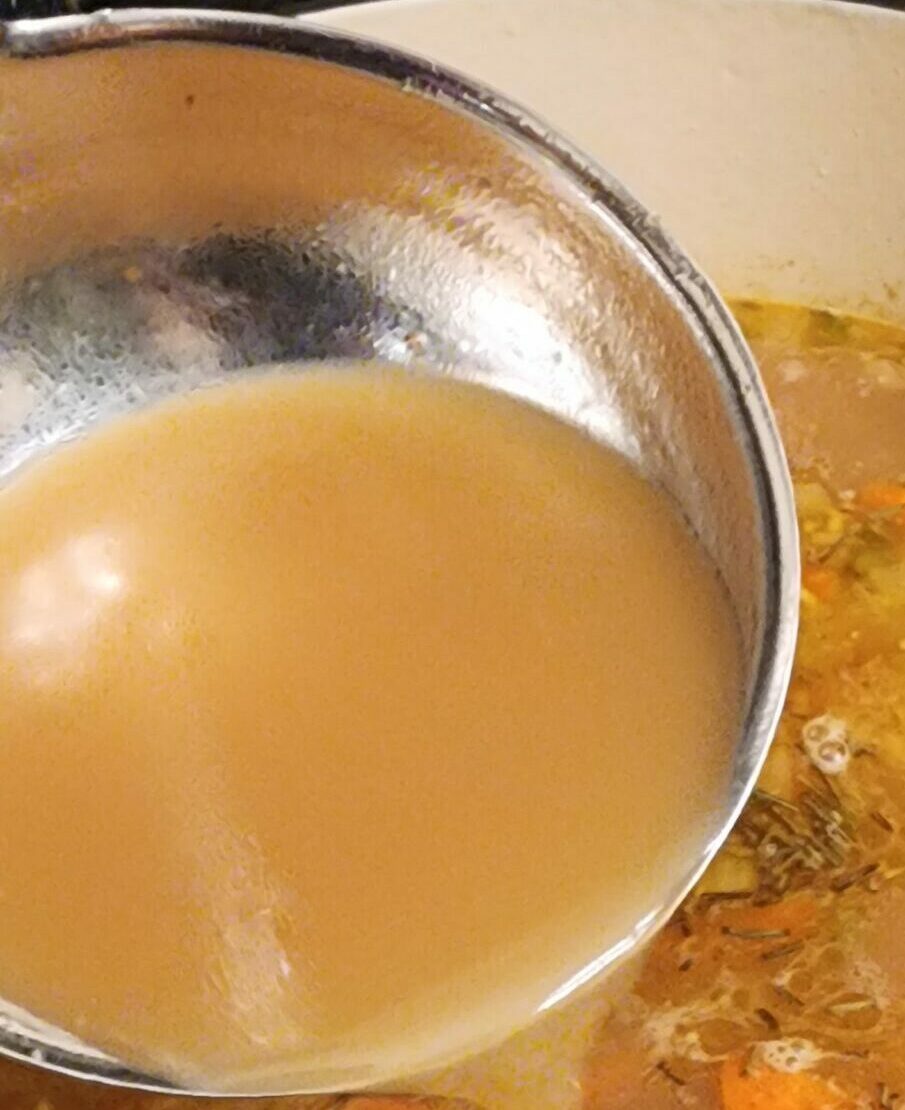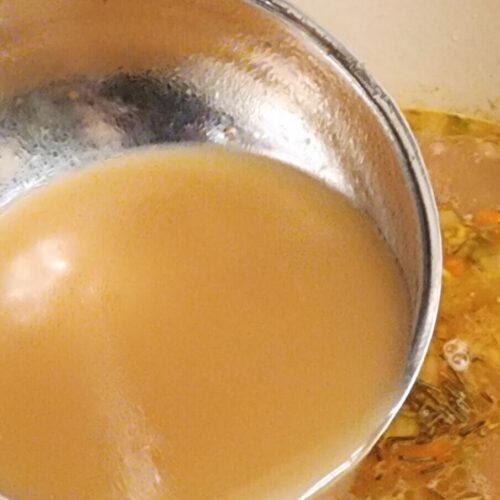Homemade Chicken Broth Recipe

Learn how to make this versatile homemade chicken broth recipe, a staple ingredient in so many recipes, to enhance your from scratch cooking.
There is some confusion about the difference between chicken broth and chicken bone broth, the main difference is the time you cook them and the amount of liquid used to cook them. Chicken broth is made by simmering ingredients over a shorter amount of time, usually 3-6 hours. Bone broth is cooked over a much longer time, usually 48-36 hours, in order to release the marrow and nutrients from the bones and evaporate much of the cooking liquid.
Chicken broth is a staple in a from scratch kitchen. Some of the recipes we use it for are:
- Chicken Gnocchi Soup
- Chicken Noodle Soup
- Sausage Potato Cheese Soup
- Chicken Pot Pie
- Homemade Cream of Chicken Soup
- Broccoli Cheese Soup
- Homemade Stuffing
- Creamy Slow Cooker Chicken Pasta
- Slow Cooker Chicken Tortilla Soup
- Creamy Potato Cheese Soup
Chicken broth is one of the easiest and least expensive things to bring great flavor to your home cooked meals. Many people simply throw their chicken bones away, but by saving them, it reduces food waste and adds to your pantry!
Ingredients:
Bones – The most important ingredient in chicken broth (or bone broth) is chicken bones. I like to use at least one whole chicken carcass from a roasted chicken, or 2-3 lbs of chicken bones from previous meals (simply freeze them until you have enough).
Vegetables – You can make your broth with only bones, but I like to add vegetables or vegetable scraps and herbs to increase the flavor of the broth. To save money, and reduce kitchen waste, you can use vegetable scraps like garlic and onion skins, carrot tops, celery bottoms, etc. that will add flavor without depleting your fridge. I like to save these scraps in the freezer until I make broth.
Method
Place all ingredients into a large stock pot (I really love the quality of this stock pot) and simmer on medium heat for at least 3-4 hours. If you choose to cook longer, watch the water level to make sure it is always covering the bones. Use caution if you choose to simmer overnight and reduce the heat to low and add additional water. I like to cook my broth for 48 hours or more, until the bones crumble when crushed between my fingers. By cooking the broth until the bones are crumbly you get more nutrition from the bones and you can feed them to your animals without the risk of bones getting stuck in their throats. You can also dehydrate the bones, powder them, and use them as bone meal to add nutrients to your garden.
How to Preserve Chicken Broth
If you don’t use the broth immediately, homemade chicken broth can be stored in the refrigerator for up to a week and frozen for up to 6 months. When freezing, I like to use quart size freezer bags for 2-4 cups of broth. To save freezer space, place them flat on a baking sheet so they freeze flat. After the initial freeze, you can then stack them easily in your freezer. DO NOT try to freeze them stacked on the baking sheet, the extra pressure can cause leaks in the bags on the bottom.
For long term storage, you can easily pressure can homemade chicken broth to last up to 2 years. Chicken broth is a low acid food and all low acid foods should be pressure canned. Pressure canning increases the temperature high enough and long enough to remove the risk of botulism.

Simple Homemade Chicken Broth Recipe
Equipment
- Large stock pot
- Strainer
- quart or half gallon jars to cool strained broth.
Ingredients
- 1 chicken carcass
- 1 small onion
- 2 cloves garlic
- 1 carrot
- 1-2 tsp kosher salt
- 4 black peppercorns
- 1 tsp thyme, dried
- 1 tsp rosemary, dried
- 1-2 gal water
Instructions
- Place all ingredients into the stock pot and cover with water.
- Simmer over medium-low heat for 4-30 hours. I prefer to cook it longer to release more flavor from the bones. If you choose to cook for a longer time, you will have to watch it and replenish the water as needed.
- Strain the broth and ladle into clean glass jars. Allow to cool and skim fat from the top. If not used immediately, refrigerate up to a week or freeze up to 6 months.
Some of the links in the above article are affiliate links. This means that, at no additional cost to you, I will earn an affiliate commission if you click through the link and finalize a purchase.